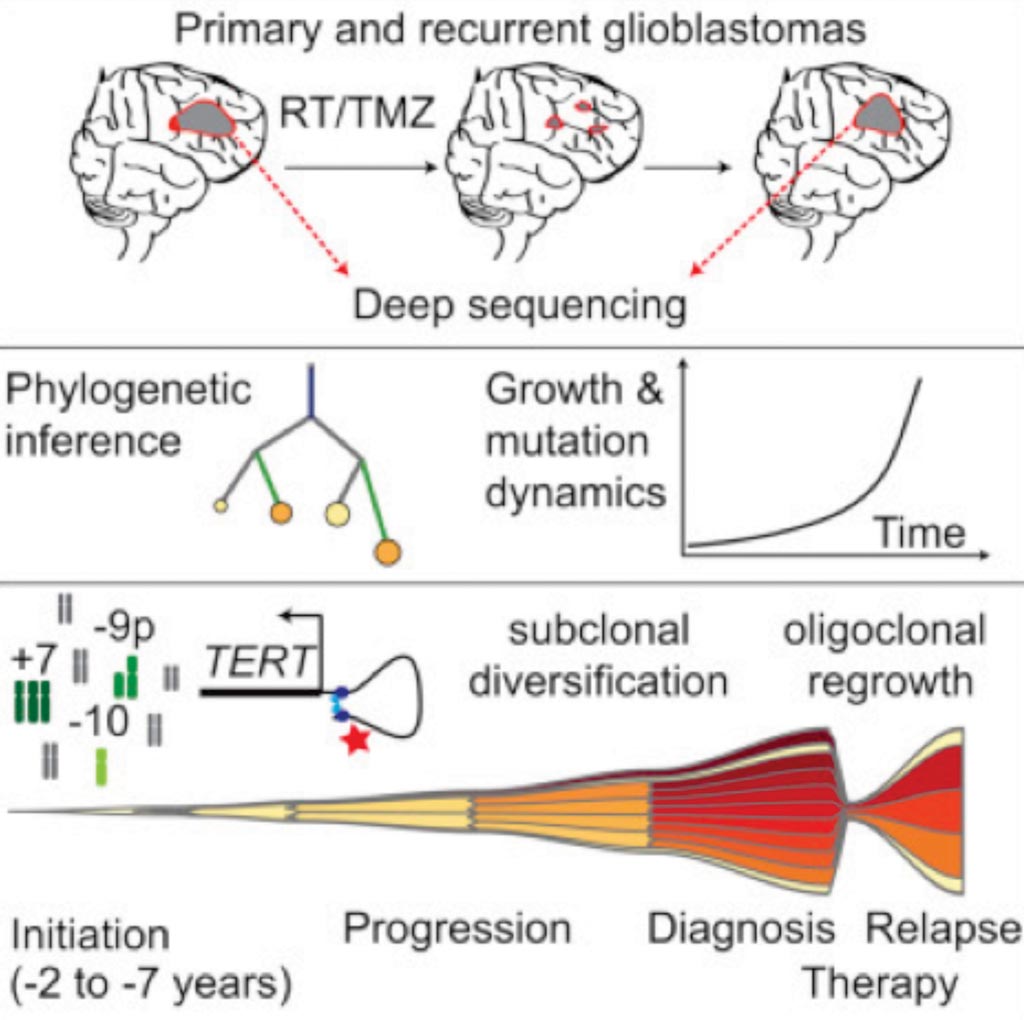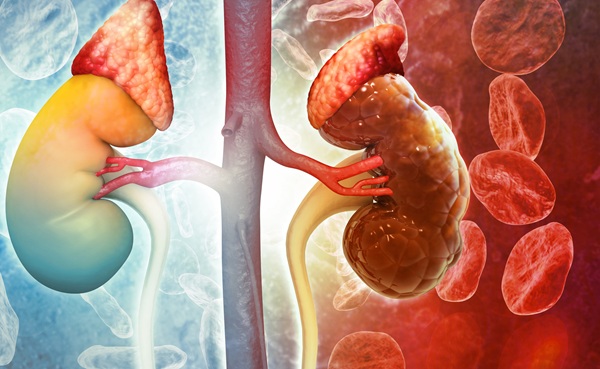Glioblastoma Driver Mutations Appear Long Before Diagnosis
|
By LabMedica International staff writers Posted on 03 Apr 2019 |

Image: A diagram of evolutionary trajectories of IDH-WT glioblastomas revealing a common path of early tumorigenesis instigated years ahead of initial diagnosis (Photo courtesy of German Cancer Research Center).
Glioblastomas are the most common high-grade (cancerous) primary brain tumor in adults. They can also occur, rarely, in children. Glioblastomas belong to a group of brain tumors known as gliomas, as they grow from a type of brain cell called a glial cell.
Diverse glioblastoma (GBM) tumors falling into several distinct methylation-based subgroups tend to share early driver mutations, which appear to have arisen long before individuals' initial GBM diagnoses and influence genetic features found in the tumors present at disease recurrence.
Scientists at the German Cancer Research Center (Heidelberg, Germany) and their colleagues performed whole-genome sequencing on tumor-matched blood sample controls from 21 GBM patients, along with RNA sequencing on primary and recurrent tumor samples. They also considered pairs of primary and recurrent tumors from 43 patients with IDH-wild type GBM that were profiled with targeted sequencing on 50 glioma-related genes, and used Illumina BeadChip arrays to assess DNA methylation levels across tumor samples from both groups.
The team found that by integrating these molecular data in phylogenetic and tumor growth, mutation, and evolution modeling, they were able to track down apparent initiating mutations involving chromosome 7 gains or chromosome 9 and 10 losses that appeared an estimated two to seven years before the patients' GBM diagnoses, along with mutations affecting the telomerase reverse transcriptase (TERT) promoter that appeared to mark tumor transitions to a rapid growth phase.
The authors suggested that their findings imply that standard therapy exerted little selective pressure on most recurrent tumors since the vast majority of driver mutations were acquired prior to initial diagnosis and only few drivers were acquired after initial treatment. Relapsed tumors acquired no stereotypical pattern of mutations and typically regrew from oligoclonal origins, suggesting sparse selective pressure by therapeutic measures. The study was published on March 21, 2019, in the journal Cancer Cell.
Related Links:
German Cancer Research Center
Diverse glioblastoma (GBM) tumors falling into several distinct methylation-based subgroups tend to share early driver mutations, which appear to have arisen long before individuals' initial GBM diagnoses and influence genetic features found in the tumors present at disease recurrence.
Scientists at the German Cancer Research Center (Heidelberg, Germany) and their colleagues performed whole-genome sequencing on tumor-matched blood sample controls from 21 GBM patients, along with RNA sequencing on primary and recurrent tumor samples. They also considered pairs of primary and recurrent tumors from 43 patients with IDH-wild type GBM that were profiled with targeted sequencing on 50 glioma-related genes, and used Illumina BeadChip arrays to assess DNA methylation levels across tumor samples from both groups.
The team found that by integrating these molecular data in phylogenetic and tumor growth, mutation, and evolution modeling, they were able to track down apparent initiating mutations involving chromosome 7 gains or chromosome 9 and 10 losses that appeared an estimated two to seven years before the patients' GBM diagnoses, along with mutations affecting the telomerase reverse transcriptase (TERT) promoter that appeared to mark tumor transitions to a rapid growth phase.
The authors suggested that their findings imply that standard therapy exerted little selective pressure on most recurrent tumors since the vast majority of driver mutations were acquired prior to initial diagnosis and only few drivers were acquired after initial treatment. Relapsed tumors acquired no stereotypical pattern of mutations and typically regrew from oligoclonal origins, suggesting sparse selective pressure by therapeutic measures. The study was published on March 21, 2019, in the journal Cancer Cell.
Related Links:
German Cancer Research Center
Latest Molecular Diagnostics News
- Blood Biomarker Improves Early Brain Injury Prognosis After Cardiac Arrest
- Biomarkers Could Identify Patients at High Risk of Severe AKI After Major Surgery
- CLIA Test Identifies Head and Neck Cancer Recurrence from Post-Surgical Lymphatic Fluid
- New 15-Minute Hepatitis C Test Paves Way for Same-Day Treatment
- Ovarian Cancer Assay Outperforms Traditional Tests in Early Detection
- Ultrasensitive Method Detects Low-Frequency Cancer Mutations
- Blood Test Enables Non-Invasive Endometriosis Detection
- New Blood Biomarkers Help Diagnose Pregnancy-Linked Liver Complication
- Simple Urine Test to Revolutionize Bladder Cancer Diagnosis and Treatment
- Blood Test to Enable Earlier and Simpler Detection of Liver Fibrosis
- Genetic Marker to Help Children with T-Cell Leukemia Avoid Unnecessary Chemotherapy
- Four-Gene Blood Test Rules Out Bacterial Lung Infection
- New PCR Test Improves Diagnostic Accuracy of Bacterial Vaginosis and Candida Vaginitis
- New Serum Marker-Editing Strategy to Improve Diagnosis of Neurological Diseases
- World’s First Genetic Type 1 Diabetes Risk Test Enables Early Detection
- Blood Test to Help Low-Risk Gastric Cancer Patients Avoid Unnecessary Surgery
Channels
Clinical Chemistry
view channel
POC Breath Diagnostic System to Detect Pneumonia-Causing Pathogens
Pseudomonas aeruginosa is a major cause of hospital-acquired and ventilator-associated pneumonia, particularly in lung transplant recipients and patients with structural lung disease. Its ability to form... Read more
Online Tool Detects Drug Exposure Directly from Patient Samples
Doctors often rely on patient interviews and medical records to determine what medications a person has taken, but this information is frequently incomplete. People may forget drugs they used, take over-the-counter... Read moreMolecular Diagnostics
view channel
Blood Biomarker Improves Early Brain Injury Prognosis After Cardiac Arrest
After a cardiac arrest, many patients remain unconscious for days, leaving doctors and families facing uncertainty about whether meaningful recovery is possible. Current tools to assess brain damage, including... Read more
Biomarkers Could Identify Patients at High Risk of Severe AKI After Major Surgery
Acute kidney injury is one of the most common and dangerous complications after major surgery, particularly among patients in intensive care. Even mild impairment of kidney function can lead to long-term... Read more
CLIA Test Identifies Head and Neck Cancer Recurrence from Post-Surgical Lymphatic Fluid
While the lymphatic system’s critical role in metastasis has long been recognized, routine access to patient lymph has been elusive. Now, a non-invasive process can access lymph through the collection... Read moreHematology
view channel
MRD Tests Could Predict Survival in Leukemia Patients
Acute myeloid leukemia is an aggressive blood cancer that disrupts normal blood cell production and often relapses even after intensive treatment. Clinicians currently lack early, reliable markers to predict... Read more
Platelet Activity Blood Test in Middle Age Could Identify Early Alzheimer’s Risk
Early detection of Alzheimer’s disease remains one of the biggest unmet needs in neurology, particularly because the biological changes underlying the disorder begin decades before memory symptoms appear.... Read more
Microvesicles Measurement Could Detect Vascular Injury in Sickle Cell Disease Patients
Assessing disease severity in sickle cell disease (SCD) remains challenging, especially when trying to predict hemolysis, vascular injury, and risk of complications such as vaso-occlusive crises.... Read more
ADLM’s New Coagulation Testing Guidance to Improve Care for Patients on Blood Thinners
Direct oral anticoagulants (DOACs) are one of the most common types of blood thinners. Patients take them to prevent a host of complications that could arise from blood clotting, including stroke, deep... Read moreImmunology
view channelBlood Test Could Detect Adverse Immunotherapy Effects
Immune checkpoint inhibitors have transformed cancer treatment, but they can also trigger serious immune-related adverse events that damage healthy organs and may become life-threatening if not detected early.... Read more
Routine Blood Test Can Predict Who Benefits Most from CAR T-Cell Therapy
CAR T-cell therapy has transformed treatment for patients with relapsed or treatment-resistant non-Hodgkin lymphoma, but many patients eventually relapse despite an initial response. Clinicians currently... Read moreMicrobiology
view channel
Blood-Based Diagnostic Method Could Identify Pediatric LRTIs
Lower-respiratory tract infections (LRTIs) are a leading cause of illness and death worldwide, and pneumonia is the leading infectious cause of death in children under five, claiming the lives of over... Read more
Rapid Diagnostic Test Matches Gold Standard for Sepsis Detection
Sepsis kills 11 million people worldwide every year and generates massive healthcare costs. In the USA and Europe alone, sepsis accounts for USD 100 billion in annual hospitalization expenses.... Read moreRapid POC Tuberculosis Test Provides Results Within 15 Minutes
Tuberculosis remains one of the world’s deadliest infectious diseases, and reducing new cases depends on identifying individuals with latent infection before it progresses. Current diagnostic tools often... Read more
Rapid Assay Identifies Bloodstream Infection Pathogens Directly from Patient Samples
Bloodstream infections in sepsis progress quickly and demand rapid, precise diagnosis. Current blood-culture methods often take one to five days to identify the pathogen, leaving clinicians to treat blindly... Read moreTechnology
view channel
Machine Learning Models Diagnose ALS Earlier Through Blood Biomarkers
Amyotrophic lateral sclerosis (ALS) is a rapidly progressive neurodegenerative disease that is notoriously difficult to diagnose in its early stages. Early symptoms often overlap with other neurological... Read more
Artificial Intelligence Model Could Accelerate Rare Disease Diagnosis
Identifying which genetic variants actually cause disease remains one of the biggest challenges in genomic medicine. Each person carries tens of thousands of DNA changes, yet only a few meaningfully alter... Read moreIndustry
view channel
BD and Penn Institute Collaborate to Advance Immunotherapy through Flow Cytometry
BD (Becton, Dickinson and Company, Franklin Lakes, NJ, USA) has entered into a strategic collaboration with the Institute for Immunology and Immune Health (I3H, Philadelphia, PA, USA) at the University... Read more




















